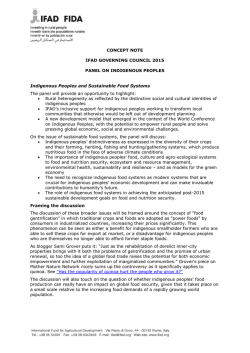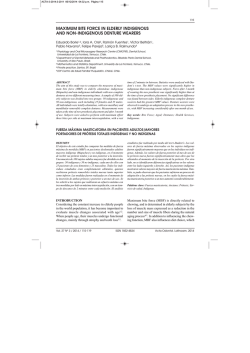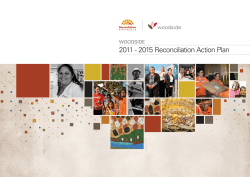
Publicaciones | Banco de la República (Banco central de Colombia)
Ethnic Earnings Gap in Colombia Ximena Peña Daniel Wills1 VERY PRELIMINARY: May 2010 Abstract We study the earnings gap against indigenous and afro-descendants, separately, and use the non-parametric decomposition approach proposed by Ñopo (2008) to understand the role of observable characteristics and historical legacies in explaining it. The earnings gap against indigenous workers is about 70%, over three times higher than the one against afrodescendants. For indigenous populations, the unexplained portion of the gap is almost one third of the total gap, while for afro-descendants it is either low or insignificant. Minorities are underrepresented in formal jobs and some types of employment; region and housing surroundings are important in explaining the gap. Keywords: Ethnicity, wage gaps, discrimination, Colombia, matching. JEL Codes: A14, D31, J17, J71 1 Authors are, respectively, Assistant Professor and Master Student of Economics at Universidad de Los Andes. We are grateful to Juan Ricardo Aparicio, Juan Camilo Cárdenas, Alejandro Hoyos, Carolina Lozano, Juan Pablo Mosquera, Hugo Ñopo , César Rodríguez and María Alejandra Vélez for helpful comments, and also to participants to the seminar “Compared Affirmative Actions: Brazil, Colombia, U.S.A”, Universidad de Los Andes, April 2010. Any mistake is ours. 1. Introduction Latin America is one of the most unequal regions in the world: it scores 17.5 points more than countries in the OECD from the 1970’s through the 1990’s (World Bank, 2003). Historically, afro-descendants and indigenous populations are among the most vulnerable groups. Race and ethnicity are “enduring determinants of one's opportunities and welfare in Latin America”. Indigenous and Afro-descended people are “at a considerable disadvantage with respect to whites”, according to World Bank (2003). Colombia is one of the most unequal countries in Latin America: its GINI index, 58.7, is only surpassed in the region by Haiti2. Thus, it is interesting to study what is the situations of the vulnerable groups is in the country. Colombia is an ideal country to compare the discrimination against indigenous and afrodescendants. A high percentage of the population is afro-descendant, and it is among the countries with a high percentage of indigenous population in the Andean region. In spite of this, few papers have studied ethnic wage3 gaps in the country; several study afro-descendants exclusively, and the rest combine both groups; not a single one treats the earnings gap against indigenous workers exclusively. The Colombian government and Constitution have tried to protect ethnic minorities, particularly via reservations for indigenous groups and collective land titling for afro-descendants. From 1966 Indian reservations were promoted as a form of collective interim possession, and by 1977 Colombian law began to confer them the legal status of “shelter”. On the other hand, the process of collective titling of land to afro-descendant communities in the Pacific Region began after the 1991 Colombian Constitution, and has to date assigned collective land titles to more than five million hectares of land. The adoption of these measures contrasts with the lack of systematic evidence of race discrimination in the country. More importantly, different kinds of discrimination should be attacked in different ways. As stated by Bernal and Flabbi (2005) “if lower average incomes among blacks and indigenous are due to lower human capital endowments and not to labor market discrimination, then policies aimed at the schooling market should prove more effective than policies directly aimed at labor market outcomes”. The purpose of this paper is, precisely, to evaluate to what extent observed differences in wages between minorities and non minorities can be explained by differences in observable characteristics. We find that the gap against indigenous populations (70%) is 3.5 higher than the one against afro-descendants. Furthermore, the gap against afro-descendant can be explained by observable characteristics (including what we call historical legacies) whereas the gap against indigenous cannot. Therefore, there is a sizeable unexplained component of the gap for the case of indigenous workers, and a low or insignificant one for afro-descendants. Secondly, we find that minorities are less likely to get some types of employments and formal jobs, and that this accounts for one third of the fraction of the gap that is not explained by differences in human capital or gender for indigenous and about one fifth for afro-descendants. Finally, our results suggest that where you live is important in explaining the gap. Specifically, minorities live in depressed neighborhoods, and less wealthy regions than non-minorities. This accounts for the total unexplained component for afro-descendants and about one fifth for indigenous. 2 3 Human Development Report 2009, United Nations In this paper we use the terms wage and earnings interchangeably These results contribute to the literature on group-based inequality in three ways. First, we provide new evidence to address the question of inequality against ethnic minorities in Colombia, which has received little attention. Secondly, it studies indigenous population and afro-descendant separately, and therefore sheds light in the differential nature, magnitude and source of the problems. Lastly, it incorporates elements of other social sciences, regarding the importance of historical legacies, in the interpretation of the gap decompositions. This paper is divided into six sections, being this introduction the first. In the next section, we review the literature on the theoretical explanations for systematic lower wages observed among ethnic minorities, proposed by economists and non-economists. We also review the empirical evidence regarding the composition of the gap in the Latin American context. Third section addresses methodological issues. This paper takes advantage of the unusual inclusion of information on ethnic belonging in the national household survey. These data are described in section 4. Fifth section is devoted to the description of the results; and last section concludes. 2. Literature Review There are two leading theories of group-based discrimination in economics. The first is attributed to Becker and is usually referred to as taste-based discrimination. The intuition behind the theory is that some individuals prefer not to interact with a particular group of people (prejudice), and are willing to ‘pay’ to avoid such interactions. The other leading explanation is based on incomplete information. If there are asymmetric beliefs regarding the average values of relevant job-related variables across groups, group averages are used as a proxy for the individual variables. Thus, utility maximizing agents may treat different groups differently, even if they share identical observed characteristics in every other aspect (see for example Moro 2009). Note that the previous approaches focus on individual behavior as the source of racism. A more modern conceptual approach, called “structural racism” involves institutional and historical legacy. These structures would curtail socioeconomic opportunities for some groups (Marable 2001). For the Kirwan Institue of the Ohio State University, “The word "racism" is often commonly translated to mean one individual intentionally or unintentionally targeting other people for negative treatment because of their skin color or other group-based physical characteristics. Using this definition, people who behave in racist ways are seen as out of style, a view that falsely and dangerously frames racism as a thing of the past, an obsolete historical phenomenon. Let's move beyond this individualist conceptualization. Racialized outcomes do not require racist actors. Racism is structural. Structural racism has a dual meaning. On one hand, the term describes racism as a system of social structures that produce cumulative, durable, race-based inequalities. On the other hand, structural racism is a method of analysis that is used to examine how historical legacies, individuals, structures, and institutions work interactively to distribute material and symbolic advantage and disadvantage along racial lines-a way of sorting who's in and who's left out of society. This shift to an analysis centering on structures, rather than on one-on-one interactions, produces important differences in understanding the process for developing and maintaining racial inequities.” (Kirwan Institute for the Study of race and Ethnicity) Under the above framework, decomposing the gap can provide information on whether there is discrimination and which of the models described above fits the data better. The ethnic gap has been empirically analyzed in region (see for example Cunningham and Jacobsen (2004), Atal, Ñopo and Winder (2009) for studies combining indigenous and afro-descendants, Ñopo, Saavedra and Torero (2007), Ñopo and Winder (2008) for indigenous populations). In the Colombian case, there are few studies on the topic, probably due to the scarce data sources including questions on ethnicity. Bernal and Flabbi (2004) use the Living Standards Survey of 2003 to study the gap against minorities, defined as afro-descendants and indigenous. The authors find that once you control for observable characteristics, the average wage of the minority is statistically equal to the average wage of non-minorities. However, there is wide variation across regions: significant positive and negative gaps that cancel each other in the aggregate. Subsequent literature focuses on afro-descendants alone, and finds that the bulk of the gap is explained by differences in endowments. For example, Romero (2007) finds that between 5 and 7 percentage points of the total gap 23% remains unexplained after controlling for observable characteristics. Rojas-Hayes (2008) considers Mincer equations at the national level using the Living Standards Survey 2003. Again, once she controls for observable characteristics there is no wage gap. Because ‘discrimination’ is usually associated with the unexplained component of the gap, the paper suggests that there is no statistical evidence of discrimination. 3. Matching Decomposition The decomposition of wage gaps has been addressed since the seminal work of Blinder (1973) and Oaxaca (1973). Although many extensions of the methodology have been proposed, all of them are either based on linear or quantile regression. The literature has documented some shortcomings of this approach. First, estimates using recent data violate key implications of the Mincerian model (Heckman, Lochner and Todd 2002). Second, the comparison is not -and should be- restricted only to comparable individuals. The failure to recognize this fact may cause serious errors in the gap decomposition (Barsky, et al. 2001, Ñopo 2008). Third, the relationship governing characteristics and wages is not necessarily linear. Fourth, the gap estimated by linear regressions is based on a logarithmic approximation. This approximation substantially underestimates large gaps, as the one reported in this paper against indigenous communities4. Instead, this paper uses a non-parametric approach proposed by Ñopo (2008), which is not based on a Mincer-type equation, relaxes the linear assumption, restricts the comparison only to comparable individuals and does not use a logarithmic approximation. In practice we find that minorities do not reach some combination of observable characteristics that are reached by non minorities (that is, there are differences in the support of the conditional distributions of characteristics). The methodology divides the observed earnings gap into four components. Let us use the indigenous minority to illustrate the decompositions. It starts by comparing each indigenous 4 The actual gap of 70% would be estimated around 50% by the methods based on linear regressions. worker in the sample with a synthetic individual built as the average of non- minorities having exactly the same set of observable characteristics. This gives an estimated gap for each set of characteristics observed among indigenous workers. Integrating over the support of the distribution of characteristics of indigenous, we get the first component: the part of the gap that cannot be explained by differences in observable characteristics, called Δ . The second component corresponds to the fact that there are some combinations of indigenous characteristics that cannot be found among non-minorities, Δ . We calculate it by comparing the average wage of this unmatched indigenous with the average indigenous and weighting by the size of the set of indigenous out of the support. The third component takes into account the fact that some non minorities were never matched with indigenous with the same characteristics. The differences between their average wage and the average non-minority, adjusted by the number of unmatched non-minorities gives the component of the earnings gap, Δ , that exists because some combinations of characteristics of non-minorities are not reached by indigenous. Finally, a fraction of the gap is explained because for a given set of characteristics, there are different numbers of indigenous and non-minorities endowed with it. This last component is therefore due differences in observed characteristics, Δ , and it is calculated by comparing the expected earnings of a non-minority with the expected earnings of the synthetic non minorities built to be matched with indigenous. The methodology described above has the advantage of capturing the existence of social structures that do not allow minorities to achieve the characteristics needed to produce higher revenues. Among its disadvantages is the “curse of dimensionality” which limits the number of explanatory variables that can be simultaneously added. 4. Data Description Few surveys include information about ethnicity and labor-related variables simultaneously. Data for this paper is drawn from the Colombian Household Survey (HS)5, which included a question on self-reported ethnicity between August 2006 and December 2007. The HS is a nationally representative survey that gathers information about demographic and socioeconomic characteristics of the population. It is important to bear in mind that we only consider population self-ascribed as afro-descendant or as indigenous. World Bank (2005) emphasizes that there is a "big difference" between the African-Colombians that are self-defined as such and the actual African-Colombian population (between 8.3 and 10.5 millions). This difference can drive to biases in the results. The results of this work must be interpreted with regard to those who self-defined as belonging to a minority. We restrict our sample to people who are between 18 and 65 years of age and who have a complete set of covariates. In addition, we do not consider individuals working less than 16 hours a week or more than 64, or individuals who score at 1 or 99 percentiles of the wage 5 Gran Encuesta Integrada de Hogares, in Spanish. distribution, to decrease measurement error (see Appendix A for details of the sample selection). Table 1 displays some descriptive statistics for the groups under consideration. The differences between non-minorities and each of the minority groups for every variable presented are statistically significant to 1%. Ethnic minorities earn on average lower hourly wages than their non-minority peers; earnings are substantially lower for indigenous workers. Minority workers are relatively older and less educated. The education distributions between groups differ largely. We build nine educational categories: none (workers with no completed years of education) primary (one to five completed years of education), basic secondary (six to nine completed years of education), secondary (10 to 11 completed years of education), incomplete tertiary (tertiary education without diploma), complete tertiary (tertiary education with diploma), technical or technological, and graduate. Half of the indigenous population has only completed primary education, while this proportion is only one third in the other two groups. On the other hand, non minorities are over represented at high education levels. There are also differences in terms of marital status. We use six categories of marital status. According to the law, after two years, cohabiting couples acquire economic rights, thus we differentiate the categories less than two years and two years of more for cohabitation. Additionally, we consider separated or divorced, widower, never married and married. Ethnic minorities and specially afro-descendants are more likely to cohabit, while non-minorities are over represented in categories married and never married. Non minorities are more often heads of household. Next, we say that there is presence of extended family in the household, if there is at least a relative other than parent, children or siblings in it. The survey also includes questions about care of children, elderly or handicapped. Regarding the presence of extended family in the household and the worker reporting to be devoted to child care, afro-descendants have the highest levels, followed by nonminorities, and finally indigenous populations have the lowest levels. The order is reversed when considering the care of an elderly or a handicapped person. Regarding labor-related variables, according to available data, we distinguish six categories of employment types. These are private wage earner, public wage earner, journeyman or laborer, housemaid, self employed, and business owner or employers. There are big differences in the type of employment. Minorities are concentrated in low-paying occupations such as selfemployment and housemaid, while non minorities are more likely to be private wage earners. Moreover, minorities have higher levels of informality, defined as non contributions to health. Indigenous workers tend to work fewer hours than the other groups (a significant proportion of indigenous work part time) and are highly overrepresented in the primary sector6. 6 We constructed 10 business industry sector categories from the reported 2-digit economic sector classification: Primary sector (agriculture, farming and extracting activities), Manufacture I (food, beverages, textiles, clothing and shoes), Manufacture II (intermediate goods), Manufacture III (furniture and capital goods), Construction (construction and distribution of gas, water, electricity), Trade (wholesale and retail trade), Entertainment (hotels, restaurants, bars and other entertainment services), Transportation, Financial, Real Estate and Business Services (finance, insurance, business, telecommunications, courier, information technology, equipment rental, real estate), Social Services (education, health, security) and Household and Personal Services. Last but not least, are area, socio-economic strata and region. Area refers to rural or urban type of living quarters. Two thirds of indigenous workers live in rural areas, while the proportion for afro-descendants and non-minorities is 34% and 26%, respectively. Stratum, a geographic (in opposition to individual) focalization instrument used in Colombia to focalize the existing cross-subsidies in public utilities; 60% of indigenous and 40% of afro-descendants belong to the lowest stratum, while only 24% of non-minorities belong to the same stratum. The definition of stratum takes into account variables related to housing environment such as location area, utilities, sidewalks, roads, among others. Finally, we divide the Colombian territory into three main regions: the Pacific coast, the Atlantic coast and the rest of the territory. This division is driven from the actual localization of ethnic minorities displayed by Figure 1. Two thirds of ethnic minorities live in the Pacific region, while less than one third of non-minorities live in either the Pacific or Atlantic regions. Table 1 Non Minority AfroIndigenous descendant Mean Wage (base 2006) Age 18-24 25-34 35-44 45-54 55-65 Education Level None Primary (1-5) Basic Secondary (6 a 9) Secondary (10 a 13) Incomplete Tertiary Complete Tertiary Graduate Technical/Technological Gender Male Female Head of Household No Yes Marital Status Cohabitation, less than 2 years Cohabitation, more than 2 years Separated/divorced Widower Never Married 2695.9 2307.3 1606.5 18.7 31.1 26.3 17.3 6.6 18.9 31.8 24.3 18 6.9 20.6 28 26.2 17.5 7.7 4.1 28.7 14.3 26.5 5.3 9.7 3.5 7.8 7.5 31.5 16.6 24.7 4 7.3 2 6.4 9 49.9 11.8 18 2.2 5.1 1.2 3 61.4 38.6 61.7 38.3 66.8 33.2 50.4 49.6 46.5 53.5 48.4 51.6 3.9 26.4 9.7 1.7 30.7 5.2 38.4 11.5 1.8 27.3 4.6 33.1 7.6 2 27.4 Non Minority Married Presence of extended family in HH No Yes Childcare No Yes Elder/ Handicapped care No Yes Type of Employment Private Wage Earner Public Wage Earner Journeyman/ laborer Housemaid Self Employed Business Owner / employer Formality No Yes Part Time No Yes Full Time No Yes Over Time No Yes Business Industry Sector Primary Sector Manufacture I Manufacture II Manufacture III Construction Trade Entertainment Transportation Finance & Business Services Social Services HH & Personal Services Area Urban Rural AfroIndigenous descendant 27.7 15.9 25.2 93.5 6.5 93.3 6.7 94.6 5.4 82.3 17.7 77.2 22.8 83.1 16.9 98.9 1.1 99 1 98.5 1.5 65.8 9.7 9.7 5.6 8 1.1 55.5 12 6.2 9.8 15.8 0.6 34.2 9.7 18.7 7.8 26.6 3 45.5 54.5 54.1 45.9 75.3 24.7 87.7 12.3 86 14 74.7 25.3 49 51 51.6 48.4 54.7 45.3 63.3 36.7 62.4 37.6 70.6 29.4 22.2 7.4 4.9 2.6 5.7 14.3 5.8 4.2 9.4 16.9 6.7 24.8 5.1 4.2 1.9 6.8 12.5 6.6 3.9 6 17.2 11 45 4.6 2.2 2.1 4.3 7.9 4 2.4 3 15.8 8.7 74 26 66.3 33.7 39.7 60.3 Non Minority Stratum Illegal connection to electricity 1 2 3 4 5 6 Region Atlantic Pacific Rest AfroIndigenous descendant 0.6 23.7 38.4 27.8 5.8 2.2 1.1 3.9 40.6 30.4 16.9 2.6 1.4 1.4 5.7 58.4 23.4 8.1 1.2 0.7 1.1 16.1 14 69.8 18.4 58.3 23.3 19.2 60.4 20.4 *All means between non minorities and minorities are statistically different at 99% The results reported in Table 1, however, are merely descriptive statistics; they do not take into account the simultaneous role of other observable characteristics in the determination of wages. Figure 1 displays the distributions of minorities within the territory. The East of the country corresponds to the Pacific region, while the North corresponds to the Atlantic region. Ethnic minorities are located in the same broad regions, but not in the same spots within these regions. Figure 1 Distribution of Afro‐ descendant population by department Distribution of indigenous population by department 5. Results We now turn to the central question of this paper: To what extent can observed differences in wages between minorities and non minorities be explained by differences in observable characteristics? Because the distribution of observable characteristics between minorities and nonminorities is substantial, as is evident by the fact that there are statistically significant differences in all the control variables reported in Table 1, investigating the effect of multiple characteristics is challenging. Non-parametric approaches, including the present matching approach, suffer from the curse of dimensionality. As the number of matching variables increases, the likelihood of finding matches diminishes and hence the size of the common supports, as reported in the last two rows of the following tables. For the case of both indigenous and afro descendant populations, we present wage gap decomposition exercises already conditioning by the variables included in the standard mincerian analysis (age as a proxy of experience and education), plus gender. This is the starting point in all decomposition exercises. We then present three sets of decomposition exercises. First, we consider variables related to the person’s family dynamics and responsibilities, which are related to the worker’s productivity and must therefore have an impact on wages. Next, we analyze factors related to the job itself, such as type of employment, formality, or economic sector. This is supported by the idea of some kind of segmentation in the labor market which excludes minorities. We finally include variables that can be directly related to some historical tradition that perpetuates the disadvantages of the ethnic minorities. A. Indigenous Populations The raw gap against indigenous is huge: an average non-minority earns 67.8% more that an average indigenous worker. In Table 2 the decomposition exercises are shown in columns such that each column adds a variable to the matching set available in the previous one. The first column results from matching indigenous workers and non-minorities within the same age group, education level, and gender. The second column considers the previous matching characteristics and whether the individual is the head of household. The third adds upon the second by including marital status on top of the previous characteristics, and so on. The variables included are: a dummy for head of household, marital status, presence of extended family, and whether the worker has to take care of children, elderly or handicapped people in their spare time. The matching variables considered in Table 2 are those considered as individuals’ socio-demographics, without considering other job-related characteristics for the time being. The first row on Table 2 shows that non minorities earned 67.8 percent higher hourly labor earnings than minorities (measured as a percentage of average indigenous wages). When controlling for age group, education level, and gender 30 out of 68 are explained by differences in these characteristics. Another 10 points are explained because of the existence of combinations of endowments in non-minorities that do not exist in minorities, most likely related to very high education levels. The remaining 26 percentage points cannot be explained by this basic set of characteristics. As mentioned earlier, subsequent columns in Table 2 present decomposition exercises that cumulatively add new variables to the original set. In general, including additional socio-economic characteristics does not reduce the unexplained component, but rather transfers part of the gap from the portion explained by differences in the distribution of characteristics, Δ , to the portion due to the existence of combinations of endowments in non-minorities that do not exist in minorities, Δ . Including marital status substantially reduces the common support, since indigenous workers are over represented in cohabitation. However, this does not contribute to explaining a larger proportion of the gap. Table 2 – Indigenous Wage Gap Decompositions by Family Variables Δ Δ Δ Δ Δ % CS Nonminorities % CS Minorities Age, Education, Gender + Head of Household + Marital Status + Presence of Extended Family on HH + Child/ elder/ handicapped care 67.8% 26.2% 9.9% 0.0% 31.8% 67.8% 26.2% 15.1% 0.0% 26.5% 67.8% 26.4% 23.4% 0.1% 17.9% 67.8% 25.9% 23.1% 0.3% 18.5% 67.8% 26.6% 25.2% 0.4% 15.7% 94.7% 88.3% 65.7% 62.0% 54.0% 100.0% 100.0% 99.2% 98.9% 96.2% Source: Household Survey 2006-2007 The previous results suggest that the unexplained component of the earnings gap is not affected by family composition or responsibilities. Is it rather because of the job characteristics? Because only 54% of non minorities are in common support when conditioning for all socio-economic variables, the estimation has low external validity. Therefore, Table 3 presents the result of adding employment related variables to the basic conditioning set: age groups, education and gender. Because the percentage of the population in the common support rapidly declines by the inclusion of each additional variable, variables are added one by one, without accumulating. The variables included are type of employment, formality, time worked and economic sector. The final column presents the results of the decomposition when simultaneously conditioning by the complete set of job-related characteristics. The second and third columns of Table 3 show that the inclusion of both type of employment and formality reduces the unexplained component, Δ , about 8 percentage points: indigenous workers are underrepresented in highly paid types of employment and formal jobs. In both cases the unexplained component remains high, accounting for more than one fifth of the total gap. Conditioning by time worked does not affect the unexplained component, but it does decrease the portion explained by differences in characteristics, Δ , and increases the portion due to the existence of combinations of endowments in non-minorities that do not exist in minorities, Δ . Including economic activity does not affect the unexplained component, despite the fact that a sizeable fraction of indigenous work in the primary sector. This is because wages in the primary sector are low. Finally, conditioning on the full set of job-related variables presents a similar picture to what has been described, but is significantly decreases the percentage of non minorities in common support. Table 3 - Indigenous Wage Gap Decompositions by Employment Variables Δ Δ Δ Δ Δ % CS Nonminorities % CS Minorities Age, Education, Gender & Type of Employment & Formality & Time Worked & Economic Sector Entire Set 67.8% 26.2% 9.9% 0.0% 31.8% 67.8% 17.4% 16.9% 0.6% 32.9% 67.8% 18.0% 11.1% 0.0% 38.8% 67.8% 27.3% 19.4% 0.0% 21.2% 67.8% 25.6% 20.0% 0.3% 22.0% 67.8% 18.7% 21.5% 2.5% 25.1% 94.7% 83.1% 88.6% 83.5% 61.1% 24.7% 100.0% 98.8% 100.0% 100.0% 98.5% 90.1% Source: Household Survey 2006-2007 Other social sciences have emphasized the role of structural discrimination in the systematic lower income of ethnic minorities in society. Table 4 explores possible effects of the region, stratum and area on wage gaps against indigenous. Again, we begin by conditioning by the basic set of variables and include one-by-one an urban area dummy, stratum, region and the entire set. The unexplained component, Δ , is reduced by the inclusion of these variables, especially by the rural/urban dummy. Recall that two out of three indigenous live in rural areas, which may be determined by their culture, traditions as well as by historical legacy. As wages are systematically lower in rural areas, including this variable explains a larger fraction of the gap (Δ increases). Second, including stratum reduces the unexplained component by 6.7 percentage points. Indigenous are concentrated in lower strata. Stratum includes neighborhood variables such as whether roads as paved. As with other variables, the direction of the causality is difficult to assess, but this may still be interpreted as evidence of the impact of the neighborhood on the performance of indigenous in the labor markets7. Finally, including the regional variable reduces the unexplained component by 7 percentage points. If 60% of indigenous live in the Pacific region, it must be that average wages in this region are lower than 7 See Badel 2009 for evidence of the role of poor neighborhood in explaining racial inequality in the United States. in other regions, and that non-minorities endowed with particular sets of characteristics do not live in the Pacific. Table 4 - Indigenous Wage Gap Decompositions by “Perpetuating History” Variable Δ Δ Δ Δ Δ % CS Nonminorities % CS Minorities Age, Education, Gender 67.8% 26.2% 9.9% 0.0% 31.8% & Urban/ Rural area 67.8% 18.2% 10.5% -0.8% 39.9% & Stratum (Environment) 67.8% 19.5% 32.8% -0.1% 15.6% & Region 67.8% 19.2% 34.2% 0.1% 14.3% Entire Set 67.8% 17.4% 44.8% -2.5% 8.2% 94.7% 91.5% 72.0% 72.3% 37.1% 100.0% 99.7% 98.7% 99.9% 91.1% Source: Household Survey 2006-2007 To conclude, non-minorities earn on average 70% more that indigenous workers. This can be explained in a large extent by differences in human capital and gender. Nonetheless, almost 26,2 percentage points (which is 40% of the observed gap) remains unexplained. A fraction of this unexplained component is due to the fact that certain types of indigenous do not have access to formal job, and highly paid occupations. Also indigenous tend to live in rural areas and in some region with lower wages, were some kind of non-minorities do not live. Having shed those lights on the gap against indigenous, let us move on to consider the case of afro-descendants. B. Afro-descendant From descriptive statistics it is clear that the situation of afro-descendants is very different from that of indigenous. The wage gap is still substantial, but 4 times lower, at 16.8%. The education gap is also lower. They are not as concentrated in rural areas, or in the primary sector. However, they are also highly concentrated in the Pacific region: 58% of afro-descendants live there (see Table 1 in Section 4). Let us start be studying family related variables. The decomposition exercises presented in Table 5 cumulatively add the socio-economic characteristics to the basic conditioning set. Of the observed gap, 16,8 percentage points, only 3,7 percentage points remain unexplained after conditioning for the basic set, and most of the gap is explained by differences in these characteristics. As was shown for indigenous workers, including socio-economic variables does not reduce the unexplained component, since it remains around 4 percentage points. The component explained by differences in observable characteristics explains the bulk of the gap (between 11 and 12 percentage points out of 16.8). For Afro descendents the cumulative inclusion of socio-economic characteristics does not lead to such a sharp decrease in the percentage of the population in common support. Table 5 – Afro-descendant Wage Gap Decompositions by Family Variables Δ Δ Δ Δ Δ % CS Nonminorities % CS Minorities + Marital Status 16.8% 4.1% 1.8% -0.1% 11.0% + Presence of Extended Family on HH 16.8% 4.1% 1.5% 0.0% 11.2% + Child/ elder/ handicapped care 16.8% 3.8% 2.1% -0.3% 11.3% 99.0% 89.5% 86.9% 80.0% 100.0% 99.2% 98.7% 96.9% Age, Education, Gender 16.8% 3.7% 0.2% 0.0% 12.9% + Head of Household 16.8% 4.1% 0.3% 0.0% 12.4% 99.7% 100.0% Source: Household Survey 2006-2007 As in the previous case, we begin by conditioning in the basic set and add one-by-one the same set of employment-related variables. The results are similar to the case of indigenous. Once again, the interesting results are associated to formality and type of work. Including type of work reduces the unexplained component in 0.4 percentage points, and including formality does so in 1 percentage point. This is an important decrease relative to the size of this component. Although magnitudes are not comparable with indigenous, the problem is the same: afrodescendants with some observable characteristics are scarce in private-wage earning and formal jobs. When we include time worked or economic sector, the unexplained component actually increases. The portion due to the existence of combinations of endowments in non-minorities that do not exist in minorities, Δ , is particularly large when we include economic sector. This means that non-minorities who work in sectors in which afro-descendants usually do not work, earn on average more than the matched non-minorities. As this increase comes from a decrease in Δ , this differential might be explained by differences in these variables. Table 6 – Afro-descendant Wage Gap Decompositions by Employment Variables Δ Δ Δ Δ Δ % CS Nonminorities % CS Minorities Age, Education, Gender 16.8% 3.7% 0.2% 0.0% 12.9% &Type of Work 16.8% 3.3% -0.6% 0.2% 13.9% &Formality 16.8% 2.7% 0.4% 0.0% 13.8% & Time Worked 16.8% 4.5% 1.6% 0.0% 10.7% & Economic Sector 16.8% 4.8% 4.1% -0.2% 8.1% Entire Set 16.8% 2.8% -2.2% 1.8% 14.4% 99.7% 94.6% 98.7% 97.4% 87.6% 53.4% 100.0% 99.5% 100.0% 100.0% 99.4% 91.3% Source: Household Survey 2006-2007 As mentioned earlier, afro-descendants are slightly over represented in rural areas (34% vs. 26% of non-minorities) and are very concentrated in the Pacific region. As shown in Table 7, discriminating by rural or urban area reduces the unexplained component of the gap by 1,7 percentage points (one-half). Furthermore, including stratum or region reduces Δ to cero. That is, when we include stratum or region, we can explain the entire wage gap. Bear in mind that in this exercise variables are being included one-by-one. That is, the entire earnings gap against afro descendants is accounted for by differences in human capital, gender and stratum/region. Again, it is difficult to assess the sense of causality between wages and stratum. It is not clear why wages are lower in regions where afro-descendant are concentrated. However, these results seem to suggest that if there is discrimination against afro-descendant in Colombia, it is not taste-based, but exists for historical reasons, related to the concept of structural discrimination. Table 7 – Afro-descendant Wage Gap Decompositions by “Perpetuating History” Variables Δ Δ Δ Δ Δ % CS Nonminorities % CS Minorities Age, Education, Gender 16.8% 3.7% 0.2% 0.0% 12.9% & Urban/ Rural area 16.8% 2.0% 0.1% -0.2% 14.9% & Stratum (Environment) 16.8% 0.0% 8.5% 0.0% 8.4% & Region 16.8% 0.2% 3.7% 0.0% 12.9% Entire Set 16.8% 0.0% 13.1% -1.7% 5.4% 99.7% 98.2% 92.0% 93.8% 62.1% 100.0% 99.8% 98.4% 99.9% 92.0% Source: Household Survey 2006-2007 6. Concluding Remarks In this paper, we show that differences in observed characteristics cannot explain the enormous observed gap against indigenous (70%), nor afro-descendants (20%). The remaining gap can be partially explained by the fact that minorities are underrepresented in certain types of employment, or in formal jobs. Additionally, indigenous with some combinations of characteristics cannot be found in the wealthier regions of the country, or in the higher strata. We interpret this result, specially the importance of the region in which they live, as evidence of structural discrimination. Under structural segregation, the choice of the region in some way forced upon workers by historical legacy and other socioeconomic structures (as suggested by Bernal and Flabbi 2005).Region accounts for the whole unexplained component of the gap for afro-descendants, but only a fraction for indigenous. Further research is needed to enhance our understanding or the gap against indigenous. 7. References • Autor, David (2003), “Lecture Note: The Economics of Discrimination –Theory”, MIT 14.661 Fall 2003. Available at http://ocw.mit.edu/NR/rdonlyres/Economics/14-661Fall2003-Fall-2004/A6271BDB-922B-40CC-AEFA-5ACD89E6982A/0/lecture_8.pdf Recovered May 28, 2010. • Atal, Juan P., Hugo Ñopo y Natalia Winder (2009) “Gender and Ethnic Wage Gaps in Latin America”, Mimeo. Inter-American Development Bank. • Badel, A. (2009) “Understanding Permanent Black-White Inequality: Neighborhood Human Capital Externalities and Residential Segregation”. Mimeo Georgetown University. • Barsky, R. J. Bound, K. Charles, J. P. Lupton (2002) “Accounting for the Black–White Wealth Gap” Journal of the American Statistical Association. September 1, 97(459): 663-673. doi:10.1198/016214502388618401. • Becker, G. (1971) The Economics of Discrimination (2nd edition). University of Chicago press. • Bernal, R. and L. Flabbi (2005) “Economic Outcomes and Race: Is there Evidence of Discrimination in Colombia?” Research Proposal. • Blinder, A.S. (1973) “Wage discrimination: reduced form and structural estimates” Journal of Human Resources • Cunningham, W. and J. Jacobsen (2004) Group based inequalities: the roles of race, ethnicity and gender. En Inequality in Latin America and the Caribbean: Breaking with History, por De Ferranti, et al. (eds). Washington D.C: World Bank. • Heckman, J.J., L. J. Lochner and .E. Todd (2003) “Fifty Years of Mincer Earnings Regressions” Iza Discussion Paper No.775, May. • Hoyos, Alejandro, Hugo Ñopo and Ximena Peña (2010), “The Persistent Gender Earnings Gap in Colombia, 1994 – 2006”. Mimeo Inter-American Development Bank, and Universidad de Los Andes. • Kirwan Institute for the Study of race and Ethnicity, “FAQ: Structural racism”, Available at http://4909e99d35cada63e7f757471b7243be73e53e14.gripelements.com/pdfs/srqa.pdf , recovered May 28, 2010. • Marable, Manning (2001) “Structural Racism and American Democracy”, Conference Paper, Conference on Racism and Public Policy, September 2001, Durban, South Africa • Mincer, Jacob (1974), Schooling, Experience, and Earnings. Human Behavior & Social Institutions No. 2. National Bureau of Economic Research, Inc., 261 Madison Ave., New York. • Moro, Andrea(2009) “Statistical Discrimination”, The New Palgrave Dictionary of Economics, Online Edition, 2009 • Ñopo, Hugo (2008), “Matching as a Tool to Decompose Wage Gaps.” Review of Economics and Statistics 90 (2). • Ñopo, Hugo, Jaime Saavedra and Máximo Torero (2007) “Ethnicity and Earnings in a Mixed-Race Labor Market” Economic Development and Cultural Change, University of Chicago Press, vol. 55, pages 709-734. • Ñopo, Hugo and Natalia Winder (2008) “Ethnicity and Human Capital Accumulation in Urban Mexico” RES Working Papers 4619, Inter-American Development Bank, Research Department. • Oaxaca, Ronald (1973). “Male-Female Wage Differentials in Urban Labor Markets”, International Economic Review, vol. 14, núm. 3, (October), pp. 693-709. • Rojas-Hayes, Carolina M. (2008). “Race Determinants of Wage Gaps in Colombia”, Revista Economía Del Caribe nº2 págs. 31-65 • Romero, J. (2007). “¿Discriminación Laboral o Capital Humano? Determinantes del Ingreso Laboral de los Afrocartageneros”, Documentos de Trabajo Sobre Economía Regional No. 98, Banco de la República – Sucursal Cartagena. • Viáfara, C. A. y F. Urrea (2006). “Efectos de la raza y el género en el logro educativo y estatus socio-ocupacional para tres ciudades colombianas”, Desarrollo y sociedad, (segundo trimestre), pp. 115-163. • World Bank (2003), “Inequality in Latin America & the Caribbean: Breaking with History?” Washington D.C. • World Bank (2005), “The Gap Matters: Poverty and Well-being of Afro-Colombians and Indigenous Peoples”, Washington D.C., October. Appendix A Remaining Observations Original Data Missing Observations 1,156,916 Individuals between 18 and 65 years old 677,713 479,203 Individuals reporting a wage 226,815 450,898 Individuals between percentiles 2 and 99 of log wage distribution 223,249 3,566 Individuals reporting number of hours worked per week 223,218 31 Individuals working between 16 and 84 hours per week 212,721 10,497 Individuals reporting region 212,721 - Individuals reporting age 212,721 - Individuals reporting gender 212,721 - Individuals reporting relationship with the head of household 212,721 - Individuals reporting ethnic belonging 212,721 - Individuals reporting educational attainment (degree) 212,628 93 Individuals reporting years of education 212,628 - Individuals reporting urban/rural area 212,628 - Individuals reporting type of employment 212,592 36
© Copyright 2025






